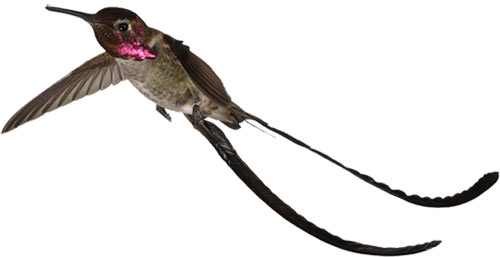 An Anna's hummingbird outfitted with borrowed feathers from the Jamaican
red-billed streamertail, a hummer that naturally sports two long tail feathers.
An Anna's hummingbird outfitted with borrowed feathers from the Jamaican
red-billed streamertail, a hummer that naturally sports two long tail feathers.Shake a tailfeather, baby!
Long, sexy tails are not a drag on male hummingbirds, study shows
| 19 March 2009
BERKELEY — The long tails sported by many male birds in the tropics look like they're a drag to carry around — not to mention a distinct disadvantage when fleeing predators. But experiments by Berkeley biologists shows that they exact only a minimal cost in speed or energy.
"We estimate that having a long tail increases a bird's daily metabolic costs by 1 to 3 percent, which means the bird has to visit 1 to 3 percent more flowers in its territory," says Christopher Clark, a graduate student in the Department of Integrative Biology. "Is that a lot? It's hard to say, but we argue that it's not, especially when compared to the costs of things like molting and migration."
Male birds of numerous species have evolved elaborate colors and decorations to attract females, many of them involving tail feathers. The peacock's eye-popping display, the broad, gauzy tail of the male lyre bird, and the two-foot-long, iridescent-green tail of the quetzal are but three examples.
Some biologists have made computer models of elongated tails, like those of the Jamaican red-billed streamertail hummingbird, the scissor-tail hummingbird, or the marvelous spatuletail hummingbird, and have predicted that flying with a long tail exacts as much as a 50 percent greater energy cost.
In his experiment, Clark outfitted short-tailed Anna's hummingbirds (Calypte anna) with long tail feathers from a red-billed streamertail (Trochilus polytmus), giving the hummingbirds two tail feathers five times the normal length for an Anna's, and put the hummers through their paces in a wind tunnel. He and Dudley found that the hummingbirds with enhanced tail feathers suffered only a 3.4 percent drop in their maximum speed, corresponding to an 11 percent increase in energy needed to fly at high speeds.
At moderate and low speeds — the speeds at which hummingbirds typically flit from flower to flower and hover — the long-tailed birds expended considerably less extra energy. While other studies are needed to establish whether the same holds true in all bird families, Clark says, "I think that in most birds with long tails, it is not costly."
A bird and a breathalyzer
Clark is writing his Ph.D. thesis on tail-feather variation among the 330 known species of hummingbirds, which occur only in the Americas. In this new experiment, Anna's hummingbirds were the controls to discover whether very long tail feathers create enough drag to significantly affect flight performance.
In visits to Jamaica, Clark collected five pairs of long tail feathers from red-billed streamertails, which molt their feathers once a year and then re-grow them. He glued two streamertail shafts to two of an Anna's own feather shafts and placed the bird in a wind tunnel to see how its metabolism was affected by hovering or flying into a breeze of up to 35 miles per hour. He enticed the hummingbird to feed in flight at a plastic tube that allowed him to collect its breath, which was analyzed for oxygen content. Of six birds tested, all expended more metabolic energy when equipped with long tail feathers. At high speeds (27 mph), they expended, on average, 11 percent more energy.
Based on these metabolic measurements, Clark and Dudley predicted that long-tailed birds would show a 3 to 4 percent decrease in maximum flight speed, which is what they found: 3.4 percent, on average.
Given that elongated tails in birds have evolved at least 26 times, if not hundreds of times, it seems as if tail-feather variation is easier to live with than, for example, wing-feather elongation, which would more likely affect flight and is rare in nature, Clark says. "We propose ... that sexual selection has generated enormous diversity in avian tail morphology because, by 'hiding' in the wake of the body, such modifications can be relatively cost-free," the researchers wrote in their paper.
Although most biologists think that extreme ornamentation, like long tails, arises because females sel-ect males based on that trait, there is still much de-bate about the evo-lutionary details. Some suggest that females have an innate bias that is exploited by males to win over females. Others suggest that long feathers are a good indication of a healthy male, and thus stand out like "tall, dark, and handsome" in human males.
"The energetic costs of a long tail are not high, but it remains to be seen if there are any benefits of a long tail, other than the indirect benefit of helping to pass on one's genes," Clark says.
Clark and Dudley reported the results of their study in the journal Proceedings of the Royal Society B, published online March 11.

